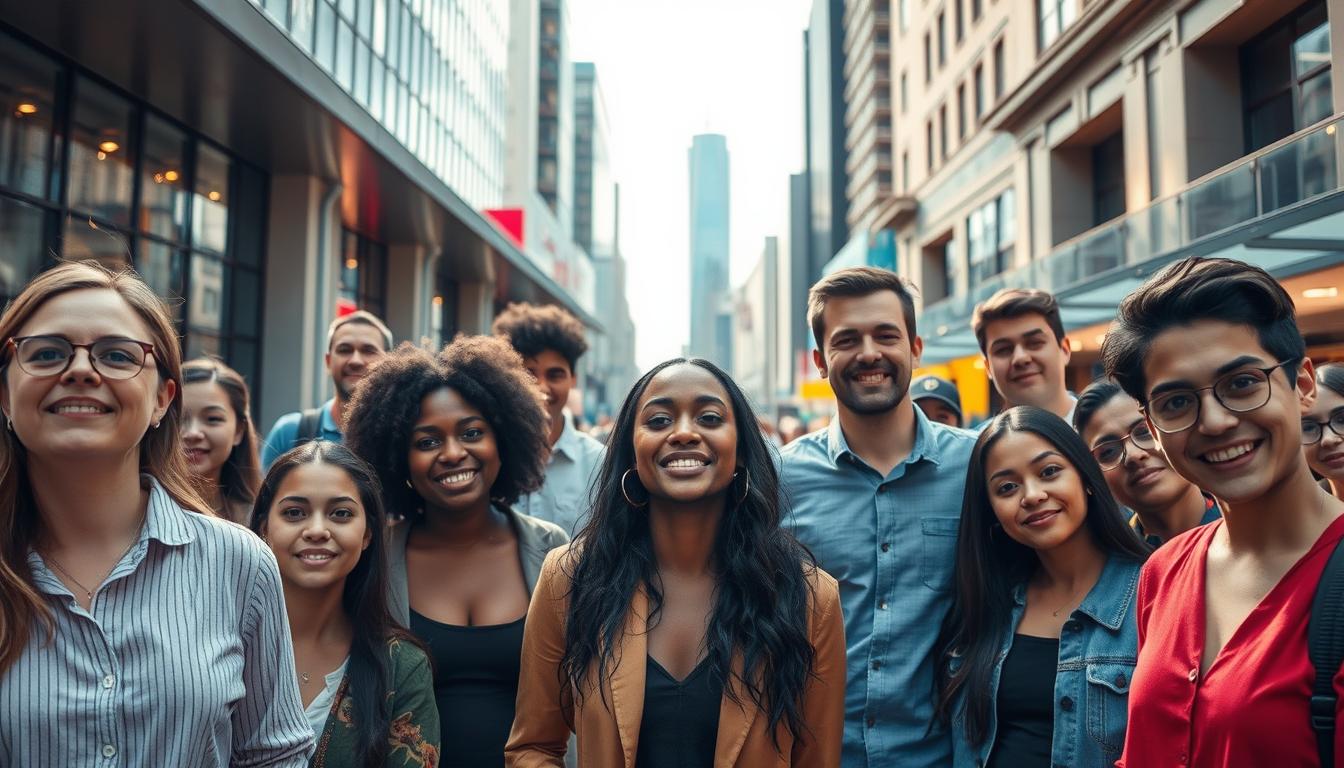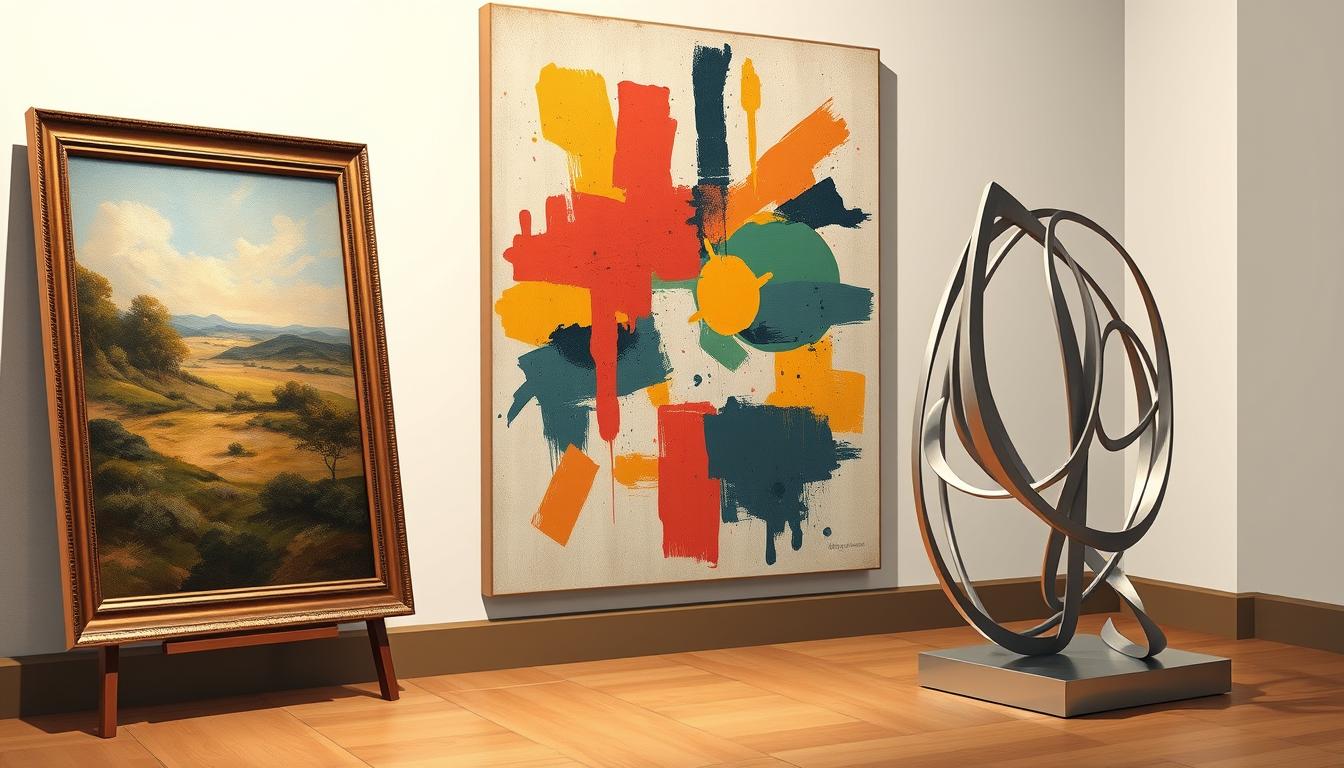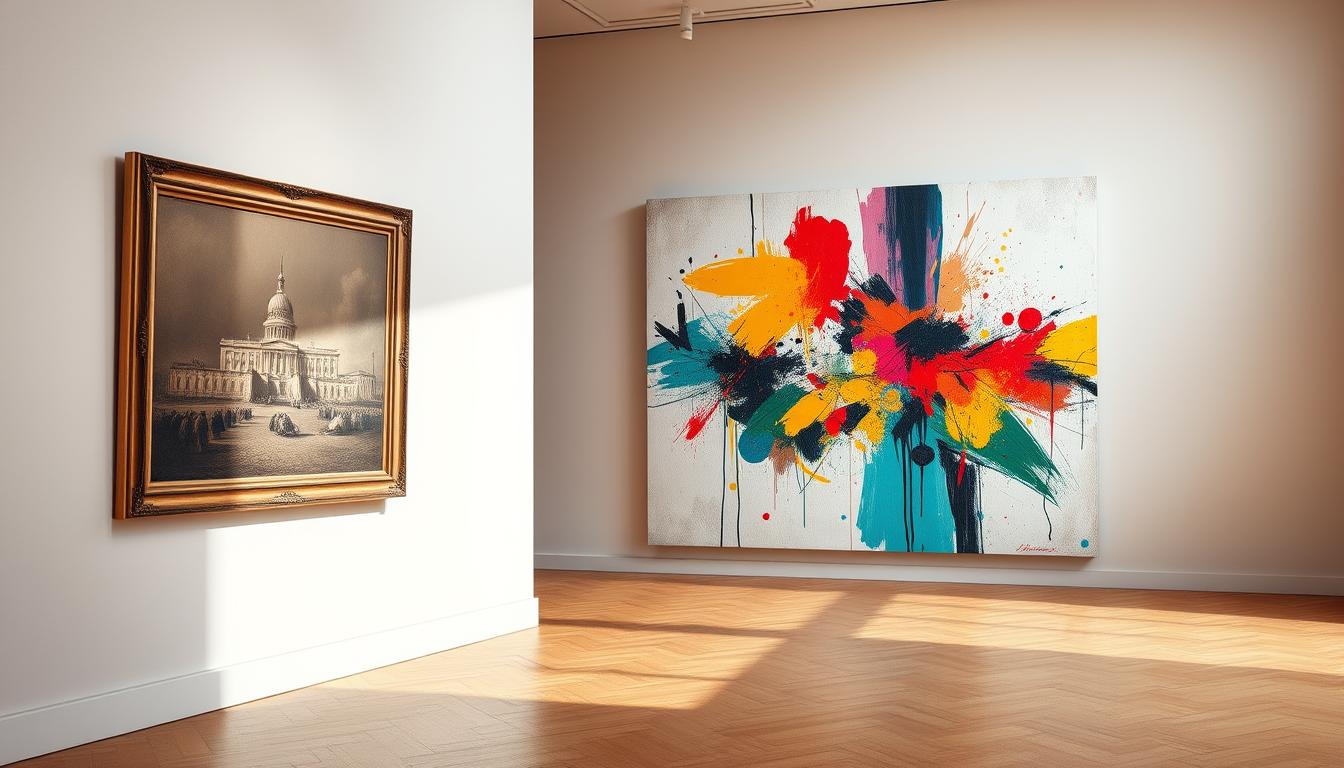Can one painting, code or room change how we feel about life today? This question opens a path into how art blends emotion, tech and daily reality. In Canada and beyond, artists mix raw feeling with tools like AI and VR to shape meaningful work.
Contemporary Expressionism lives where past breakthroughs meet new methods. It takes gestures from Rothko and Pollock and retools them for digital rooms, social feeds and gallery spaces. The result connects people to ideas and emotions in real time.
The term helps viewers and makers name a way of making that values both intuition and clear intent. Expect pieces that invite participation, spark dialogue and reflect social life with practical innovation.

Key Takeaways
- It fuses emotion with tech and material to reflect life today.
- Artists build on mid‑20th century gestures while adding digital tools.
- Social media speeds discovery and broadens who gets seen.
- Work aims for emotional truth and thoughtful execution.
- The label guides how audiences engage with present‑day art.
Defining Contemporary Expression in Today’s Art World
Artists today shape feelings into formats that invite people to step inside an idea. Contemporary art often moves beyond single objects and asks for presence, attention, and response.
From emotion to experience: how artists give shape to life, reality, and society
Contemporary expression reframes the emotional intensity of older movements through deliberate use of digital tools and social platforms. Creators mix studio craft with code, projection, and sound to make work that reads clearly and stays open to interpretation.
That balance matters. Textures, movement, and ambient sound give viewers a sense of being part of the piece. This presence changes how we connect with ideas, nature, and urban life.
- Planned hybrids combine classical techniques with experimental processes.
- Platforms like Instagram speed feedback and cross‑disciplinary projects.
- Many artists design room‑scale experiences so a single idea can become multiple formats.
What is a contemporary expression? Origins, evolution, and key influences
Early experiments in light and form set the stage for today’s bold hybrids.
From Impressionism and Cubism to Abstract Expressionism:
From Impressionism and Cubism to Abstract Expressionism
Impressionism loosened strict representation with fresh light and immediacy. Cubism fractured perspective and invited new structure. These moves opened room for greater abstraction in the 20th century.
Pollock, Rothko, and the leap from raw gesture to deliberate hybridity
In the mid century, Abstract Expressionism broke formal rules. Jackson Pollock’s drip method made motion itself part of the painting. Mark Rothko’s color fields—such as No. 5/No. 22 at MoMA—asked viewers to sit with vast color and quiet intensity.
Contemporary Expressionism: bridging tradition and innovation in the present
Joan Mitchell’s City Landscape channels energy, memory, and structure. Artists now inherit those lessons and pair them with digital tools and social platforms.

| Period | Key Shift | Representative Artist | Legacy for Today |
|---|---|---|---|
| Impressionism | Light & immediacy | Monet | Openness to perception |
| Cubism | Fractured form | Pablo Picasso | New structures for reality |
| Abstract Expressionism | Gesture & scale | Pollock / Rothko | Emphasis on feeling, scale |
| Contemporary | Analog + digital | Joan Mitchell / many artists | Hybrid tools, wider audience |
- History shows how painters and artists shifted focus across the century.
- Today, the world of art blends those techniques with networks and new platforms.
New ways of making: digital tools, AI, and social media shaping expression today
Code and lenses extend the artist's hand, letting work shift as people engage. AI, VR, and real‑time engines broaden the palette and let pieces respond to touch, sound, or motion.
Artists use digital painting software, 3D modeling, and generative systems to create patterns and textures that read as intentional choices. Sensors and projection blur physical and digital spaces, so reality can feel layered and shared.

AI, VR, and multimedia techniques expanding the palette
Real‑time engines let work evolve with audience input. Makers craft responsive installations that change color, form, or sound when people move.
Social platforms and hashtags connecting communities
Platforms like Instagram and TikTok let artists publish iterations, gather feedback, and reach people beyond major hubs. Hashtags such as #ContemporaryArt and #DigitalArt act as discovery tools and spark collaborations worldwide.
Immersive projects and virtual programs
Immersive projects by teamLab and Yayoi Kusama turn visitors into participants through light, mirrors, and motion. Museums such as Tate Modern and Centre Pompidou host virtual programs that let remote audiences attend exhibitions and learn.
- Creators pick tools—photogrammetry, AR filters, or generative models—so tech serves the idea.
- Most makers treat AI as a partner, not a replacement for human judgment.
- New ways of presenting work expand access and invite fresh questions about authorship and innovation.
| Tool | Use | Result |
|---|---|---|
| Generative AI | Pattern, texture, composition | Rapid iteration; hybrid visuals |
| VR / Real‑time engines | Immersive environments | Responsive installations; room‑scale work |
| Social platforms | Distribution and feedback | Global audience; community building |
| Photogrammetry / 3D modeling | Digitize objects and spaces | Accurate virtual exhibitions |
For further reading on tools and cultural shifts, see the cultural impact of AI. This helps Canadian artists and audiences think about how innovation reshapes the world of art today.
Where contemporary expression lives: exhibitions, galleries, and cross-disciplinary spaces
Exhibition circuits and hybrid spaces create paths for artists to share ambitious work with wider publics.
Global stages such as Art Basel and the Venice Biennale still set trends and spark debate. Institutions like Tate Modern and Centre Pompidou commission immersive shows that bring multimedia pieces to large audiences.
Global stages and major institutions
These platforms give scale and context. Curators, publishers, and educators collaborate to explain process and meaning.
Local galleries, online fairs, and Canadian access
Local galleries and artist‑run centres nurture emerging talent. Online fairs and virtual walkthroughs let Canadian people attend without travel. Hybrid programming lowers barriers and widens viewership.
Collectors, curators, and circulation
Collectors and advisors fund ambitious projects that may not fit traditional white cubes. Curators help move pieces from studio to museum, shaping how the world sees new ways of making.
"Exhibitions translate studio practice into public conversation."
- Global fairs for discovery
- Institutions for ambitious mounting
- Local and virtual shows for accessibility
| Platform | Role | Benefit |
|---|---|---|
| Biennials / Fairs | Visibility | Discovery; market access |
| Museums | Context | Curated programs; research |
| Galleries / Online | Support | Local reach; virtual sales |
Contemporary expression vs. contemporary realism and modern realism
Some artists choose exacting technique to hold the world in sharp focus. That path sits beside projects that prize scale, sensors, and mixed media. Both directions respond to reality, but they use different means.
Representational rigor today: figurative realism, photorealism, and hyperrealism
Contemporary realism often emphasizes disciplined painting: figurative realism, photorealism, and hyperrealism. These approaches use glazing, layered brushwork, and careful observation to render nature and human presence with persuasive clarity.
Juliette Aristides argues that realism helps viewers see the fragile beauty of our day. That fragile clarity can feel like careful reporting of light, texture, and form.
Branding the moment: why “contemporary,” why “modern,” and what each signals
Peter Trippi highlights why names matter. "Contemporary" signals current currency; "modern" links to mid‑20th‑century modern art. The Tate frames modern realism as realistic work produced after abstraction rose to prominence.
"Labels guide audiences but need not limit how we respond."
- Contrast: expressive practice favors atmosphere and tech; realism favors craft and depiction.
- Overlap: many artists blend both—gestural passages plus precise form.
- Takeaway: allow labels to guide, not confine, your view of art and the artist’s method.
| Approach | Primary tool | Result |
|---|---|---|
| Realist painting | Glazing, draftsmanship | Detailed depiction of reality |
| Expressive multimedia | Sensors, projection | Immersive atmosphere and affect |
| Hybrid practice | Mixed techniques | Crossed strategies that broaden sense |
Conclusion
, The story of recent art traces hands, code, and social channels that widen who can take part.
This guide shows that contemporary art connects people through shared experience and thoughtfully made work. Artists keep bridging tradition and new tools so pieces feel timely while grounded in craft.
For Canadians, mix online discovery with local visits. Follow #ContemporaryArt, browse museum virtual exhibitions, and subscribe to galleries that post projects you like.
A strong sense of encounter and quiet reflection often defines the best moments, whether in a mirrored room or on a screen. Labels help describe practice, but they do not limit how artists explore nature, life, and emotions.
Use streaming talks, artist Q&As, and catalogs to learn and support others. Beauty and society’s concerns can coexist, and your participation keeps this world vibrant and inclusive.
Enhance Your Space with Unique Modern Masterpieces
Are you inspired by the innovative mediums and conceptual depth highlighted in our exploration of contemporary art? You’re not alone! Today’s art enthusiasts are seeking cultural relevance and emotional connections in their artwork. However, finding pieces that resonate with modern themes and fit your unique style can be a challenge. That’s where we come in!
At Rossetti Art, we specialize in canvas prints, original paintings, and modern sculptures that celebrate the spirit of now. Each piece created by Chiara Rossetti brings a personal touch that connects deeply with current social narratives—just like the modern masterpieces discussed in the article. Don’t miss out on the chance to elevate your home decor with breathtaking artwork that speaks to your values and aesthetic. Explore our collection today and find your perfect piece! Act now, and transform your space into a gallery of inspiration!
FAQ
What does contemporary expression mean in today’s art world?
Contemporary expression refers to how artists shape ideas, emotions, and social concerns using current techniques and materials. It spans painting, sculpture, installation, performance, digital media, and hybrid forms that reflect life, reality, and society now. Museums, galleries, and festivals like the Venice Biennale often showcase work that questions beauty, history, and daily experience.
How do emotion and experience combine in the work artists make?
Artists translate feeling into form by prioritizing sensory impact and narrative. Some emphasize raw gesture and color to evoke emotion, while others build immersive environments or interactive pieces that invite audience participation. The aim is to create meaning that resonates with people’s lives and prompts reflection on social and cultural issues.
How did movements such as Impressionism and Abstract Expressionism influence current practice?
Earlier movements shifted focus from literal representation to perception, technique, and inner life. Impressionism opened experiments with light and observation, Cubism reworked perspective, and Abstract Expressionism foregrounded gesture and scale. Those turns allowed later artists to mix styles, materials, and ideas without strict adherence to tradition.
Why are artists like Pollock and Rothko often mentioned when discussing this evolution?
Jackson Pollock and Mark Rothko expanded how art communicates feeling through form. Pollock’s energetic surfaces and Rothko’s meditative fields proved that color, texture, and composition alone can produce profound responses. Their work cleared space for contemporary creators to explore hybridity and concept over pure representation.
How do digital tools and AI reshape how artists work?
Digital tools, AI, and virtual reality extend the artist’s palette. AI can generate patterns or suggest forms, while VR creates immersive worlds. Many artists combine software with traditional craft to explore perception and authorship. Technology also enables new distribution channels and hybrid exhibitions that blur physical and virtual boundaries.
In what ways do social platforms influence connection between creators and audiences?
Platforms like Instagram and TikTok let artists share process, sell work, and build communities directly. Hashtags and online fairs increase visibility and democratize access for collectors and curious viewers. Social media also accelerates trends and sparks collaborations across countries and disciplines.
What role do immersive projects by teamLab or Yayoi Kusama play in shaping expectations?
Immersive installations by teamLab and Yayoi Kusama popularized experiential art that engages multiple senses. These projects show how scale, light, and interaction can make art accessible and emotionally powerful, encouraging institutions to host virtual exhibitions and multisensory displays.
Where can someone see contemporary expression on display worldwide?
Major platforms include Art Basel, the Venice Biennale, Tate Modern, and Centre Pompidou. Regional galleries, biennials, and museum shows also present cutting-edge work. Online viewing rooms and virtual fairs provide additional routes for audiences who cannot travel.
How do local galleries and online fairs improve access for collectors and the public?
Local galleries nurture emerging artists and connect communities with exhibitions and events. Online fairs expand reach, letting Canadian and international buyers view, bid, and buy work remotely. These channels help diversify audiences and support sustainable practices in the market.
What distinguishes contemporary expression from representational styles like photorealism?
Contemporary approaches emphasize concept, process, and context as much as visual accuracy. Representational genres—photorealism, hyperrealism, and figurative realism—prioritize technical precision and likeness. Both can overlap, but the key difference lies in intent: concept-driven work often foregrounds idea and experience.
How do terms like “contemporary” and “modern” differ when branding work?
“Modern” typically refers to a historical period tied to 19th and 20th-century movements. “Contemporary” signals work made in the present moment, reflecting current ideas, techniques, and social concerns. Galleries and curators choose terms to position exhibitions and communicate focus to collectors and audiences.
How do curators and collectors influence which voices gain visibility?
Curators and collectors shape narratives by selecting artists for exhibitions, publications, and acquisitions. Their choices impact which themes and aesthetics receive attention. Inclusive curatorial practices and diverse collecting strategies can broaden representation and highlight underseen perspectives.
Can contemporary expression still honor tradition while innovating?
Yes. Many artists draw on art history, craft, and natural forms while experimenting with new materials and ideas. This blend keeps works grounded in technique and rich in meaning, bridging past methods with present concerns to create relevant, resonant pieces.






Leave a comment
This site is protected by hCaptcha and the hCaptcha Privacy Policy and Terms of Service apply.